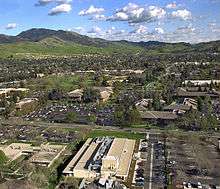Joint Genome Institute
The U.S. Department of Energy (DOE) Joint Genome Institute (JGI), first located in Walnut Creek then Berkeley, California, was created in 1997 to unite the expertise and resources in genome mapping, DNA sequencing, technology development, and information sciences pioneered at the DOE genome centers at Lawrence Berkeley National Laboratory (Berkeley Lab), Lawrence Livermore National Laboratory (LLNL) and Los Alamos National Laboratory (LANL). As a DOE Office of Science User Facility of Berkeley Lab, the JGI staff is composed of employees from Berkeley Lab, LLNL and the HudsonAlpha Institute for Biotechnology. The JGI also collaborates with other DOE-supported programs and facilities, such as the Environmental Molecular Sciences Laboratory at Pacific Northwest National Laboratory (PNNL), the National Energy Research Scientific Computing Center, or NERSC, and the DOE Bioenergy Research Centers.


History
In 1999, the University of California, which manages the three national labs for the DOE, leased laboratory and office space in a light industrial park in Walnut Creek, California to consolidate genome research activities. Led by biotechnology industry veteran Nigel Mouncey, who assumed the position of Director in March 2017, the DOE JGI receives its funding from the Office of Biological and Environmental Research in DOE's Office of Science.
Originally established to work on the Human Genome Project—the JGI generated the complete sequences of Chromosomes 5, 16 and 19—the JGI has since shifted its focus to the non-human components of the biosphere, particularly those relevant to the DOE's science mission. Since 2004, the JGI has been a user facility that advances genomics research in a broad range of disciplines where DNA sequence information is likely to drive scientific discoveries.
In February 2004, the JGI launched the Community Sequencing Program (CSP), known as the Community Science Program, which provides the scientific community at large with access to high-throughput, high-quality sequencing, DNA synthesis, metabolomics and analysis capabilities. The projects involve many important multicellular organisms, microbes and communities of microbes called metagenomes (or microbiomes) related to the DOE mission areas of bioenergy, understanding global cycles such as the carbon cycle, and biogeochemistry and are chosen primarily based on scientific merit as determined by outside review.
In 2019, the JGI had 1,933 active primary users worldwide and over 10,000 data users (those who login and download data sets or use the online tools).
Genome sequencing milestones
Plant genomes and fungal genomes that can inform the development of sustainable biofuels and bioproducts, and microorganisms such as those that thrive under extreme conditions such as high acidity, radiation and metal contamination are of particular interest to the DOE. Investigations by the JGI and its users are shedding light on plant biomass breakdown mechanisms and the cellular machinery of microbes and how they can be harnessed to clean up contaminated soil or water, capture carbon from the atmosphere and produce potentially important sources of energy such as hydrogen and methane.
In 2006, the JGI published the genome of the first tree sequenced—the cottonwood (Populus trichocarpa). In partnership with other federal institutions and universities, the JGI has also published the genome sequences of sorghum; the microbial community in the termite hindgut, which could provide enzymes useful to biofuel production; microbes such as the bacteria Desulfovibrio that clean up sites contaminated with radioactive or toxic compounds; and algae involved in the global carbon cycle.
In 2009, the JGI reached a sequencing capacity milestone, generated more than a trillion bases (Tb) generated annually. In 2011, the JGI generated nearly 30 Terabases of sequence and in 2019, the JGI generated more than 326 Tb of sequence. The JGI makes the high-quality data from genome sequencing, DNA synthesis, and metabolomics freely available to the greater scientific community on its website and on other public databases.
Data management systems
The JGI also supports programs dedicated to functional and evolutionary genomics related to the organisms and environments being sequenced and the development of computational and bioinformatic tools for data management and mining. These genome and metagenome/microbiome analysis systems include Genome Portal, Phytozome, IMG and the Genomes OnLine Database.
The Integrated Microbial Genomes System (IMG), which provides a framework for comparative analysis of primarily microbial genomes, though the system also supports eukaryotic genomes and environmental samples. Its goal is to facilitate the visualization and exploration of genomes from a functional and evolutionary perspective.
External links and sources
- DOE Joint Genome Institute (official)
- Lawrence Livermore National Laboratory (official)
- Lawrence Berkeley National Laboratory (official)
- Los Alamos National Laboratory (official)
- Genomes OnLine Database
- Map: 37°52′39.5″N 122°15′01.4″W
